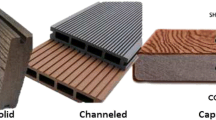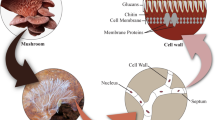Abstract
For producing wood plastic composites (WPCs) having lightweight and cost efficiency, a microcellular injection foaming process is applied in our present work. Two types of exothermic foaming agents (EFA) with different range of particle size are used for formation of microcellular structure in WPCs. This research examines effects of particle size and concentration of the exothermic foaming agents on mechanical and physical properties of WPCs. The average cell size in WPCs is decreased with increasing the content of exothermic foaming agents. The large foaming agent shows small cell size compared to the small foaming agent case. Cell population density of foamed WPCs increases with increasing the EFA content, but decreases with decreasing the size of EFA. Concerning density and void fraction of foamed WPCs, the density is reduced but the void fraction is increased with increasing the EFA concentration. For the flexural strength, increment of amount of EFA decreases the mechanical strength because of the increase of cell density and void fraction. Also, the smaller size foaming agent (an AC9000 case) increases more strength due to influence of EFA size.
Similar content being viewed by others
References
Bae, K. and Shim, J. H., “Economic and Environmental Analysis of a Wind-Hybrid Power System with Desalination in Hong-do, South Korea,” Int. J. Precis. Eng. Manuf., Vol. 13, No. 4, pp. 623–630, 2012.
Faruk, O., Bledzki, L. A. K., and Matuana, L. M., “Microcellular Foamed Wood-Plastic Composites by Different Processes: A Review,” Macromol. Mater. Eng., Vol. 292, pp. 113–127, 2007.
Lee, S. T., Park, C. B., and Ramsh, N. S., “Polymeric Foams-Science and Technology,” CRC Press, p. 135, 2007.
Klyosov, A. A., “Foreword-Overview: Wood-Plastic Composites,” John Wiley & Sons, p. 42, 2007.
Matuana, L. M., Faruk, O., and Diaz, C. A., “Cell Morphology of Extrusion Foamed Poly (lactic acid) using Endothermic Chemical Foaming Agent,” Bioresour. Technol., Vol. 100, pp. 5947–5954, 2009.
Bledzki, A. K. and Faruk, O., “Injection Moulded Microcellular Wood Fibre-Polypropylene Composites,” Compos. Part A, Vol. 37, pp. 1358–1367, 2006.
Lee, Y. H., Kuboki, T., Park, C. B., and Sain, M., “The Effects of Nanoclay on the Extrusion Foaming of Wood Fiber/Polypropylene Nanocomposites,” Polym. Eng. Sci., Vol. 51, pp. 1014–1022, 2011.
Petchwattana, N. and Covavisaruch, S., “Influences of Particle Sizes and Contents of Chemical Blowing Agents on Foaming Wood Plastic Composites Prepared from Poly (vinyl chloride) and Rice Hull,” Mater. Design, Vol. 32, pp. 2844–2850, 2011.
Guo, G., Lee, Y. H., Rizvi, G. M., and Park, C. B., “Influence of Wood Fiber Size on Extrusion Foaming of Wood Fiber/HDPE Composites,” J. Appl. Polym. Sci., Vol. 107, pp. 3505–3511, 2008.
Bledzki, L. A. K. and Faruk, O., “Microcellular Injection Molded Wood Fiber-PP Composites: Part I — Effect of Chemical Foaming Agent Content on Cell Morphology and Physico-Mechanical Properties,” J. Cellular Plast., Vol. 42, pp. 63–76, 2006.
Rachtanapun, P., Selke, S. E. M., and Matuana, L. M., “Microcellular Foam of Polymer Blends of HDPE/PP and Their Composites with Wood Fiber,” J. Appl. Poly. Sci., Vol. 88, pp. 2842–2850, 2003.
Li, Q. and Matuana, L. M., “Foam Extrusion of High Density Polypropylene/Wood Flour composites Using Chemical Foaming Agents,” J. Appl. Polym. Sci., Vol. 88, pp. 3139–3150, 2003.
Colton, J. S. and Suh, N. P., “The Nucleation of Microcellular Thermoplastic Foam with Addictives: Part I: Theoretical Consideration,” Polym. Eng. Sci., Vol. 27, pp. 485–492, 1987.
Bledzki, L. A. K. and Faruk, O., “Microcellular Injection Molded Wood Fiber-PP Composites: Part II — Effect of Wood Fiber Length and Content on Cell Morphology and Physico-Mechanical Properties,” J. Cellular Plast., Vol. 42, pp. 72–88, 2006.
Gwon, J. G., Lee, S. Y., Chun, S. J., Doh, G. H., and Kim, J. H., “Physical and Mechanical Properties of Wood-Plastic Composites Hybridized with Inorganic Fillers,” J. Compos. Mater., Vol. 46, No. 3, pp. 301–309, 2012.
Lee, C. G., Hwang, Y. J., Choi, Y. M., Lee, J. K., Choi, C., and Oh, J. M., “A Study on The Tribological Characteristics of Graphite Nano Lubricants,” Int. J. Precis. Eng. Manuf., Vol. 10, No. 1, pp. 85–90, 2009.
Lee, J., Turng, L. S., and Kramschuster, A., “The Microcellular Injection Molding of Low-Density Polyethylene (LDPE) Composites,” Polym. Plast. Technol. Eng., Vol. 49, pp. 1339–1346, 2010.
Author information
Authors and Affiliations
Corresponding author
Rights and permissions
About this article
Cite this article
Gwon, J.G., Lee, S.Y., Kang, H. et al. Effects of sizes and contents of exothermic foaming agent on physical properties of injection foamed wood fiber/HDPE composites. Int. J. Precis. Eng. Manuf. 13, 1003–1007 (2012). https://doi.org/10.1007/s12541-012-0130-3
Received:
Accepted:
Published:
Issue Date:
DOI: https://doi.org/10.1007/s12541-012-0130-3




